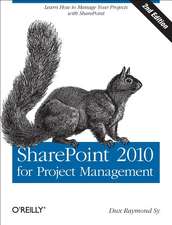Bridging the Business-Project Divide: Techniques for Reconciling Business-as-Usual and Project Cultures
Autor John Brinkworthen Limba Engleză Hardback – 29 aug 2014
| Toate formatele și edițiile | Preț | Express |
|---|---|---|
| Paperback (1) | 208.72 lei 6-8 săpt. | |
| Taylor & Francis – 24 iun 2024 | 208.72 lei 6-8 săpt. | |
| Hardback (1) | 766.66 lei 6-8 săpt. | |
| Taylor & Francis – 29 aug 2014 | 766.66 lei 6-8 săpt. |
Preț: 766.66 lei
Preț vechi: 1028.86 lei
-25% Nou
Puncte Express: 1150
Preț estimativ în valută:
146.75€ • 159.45$ • 123.35£
146.75€ • 159.45$ • 123.35£
Carte tipărită la comandă
Livrare economică 21 aprilie-05 mai
Preluare comenzi: 021 569.72.76
Specificații
ISBN-13: 9781409465171
ISBN-10: 1409465179
Pagini: 230
Ilustrații: Includes 16 b&w illustrations
Dimensiuni: 174 x 246 x 20 mm
Greutate: 0.59 kg
Ediția:New ed.
Editura: Taylor & Francis
Colecția Routledge
Locul publicării:Oxford, United Kingdom
ISBN-10: 1409465179
Pagini: 230
Ilustrații: Includes 16 b&w illustrations
Dimensiuni: 174 x 246 x 20 mm
Greutate: 0.59 kg
Ediția:New ed.
Editura: Taylor & Francis
Colecția Routledge
Locul publicării:Oxford, United Kingdom
Public țintă
Professional Practice & DevelopmentNotă biografică
John Brinkworth is a management consultant who assists clients to improve their processes for project and programme management. He is also part of the associate faculty at Henley Business School. He is a Member of the Institute of Directors (IoD), a Fellow of the Chartered Management Institute, a Certified Management Consultant (CMC®), a Chartered IT Professional and an Associate of the Chartered Quality Institute. He has previously published a book on Software Quality Management and articles in Conspectus and Project Manager Today. For the then UK Office of Government Commerce (OGC) he has also served on their review team for their publications relating to programme and project management. His focus is on identifying pragmatic solutions that can increase the chances of project success.
Cuprins
Chapter 1 Introduction; Part I The Project Lifecycle; Chapter 2 Identifying a Project; Chapter 3 Justification and Approval for a Project; Chapter 4 Getting Started; Chapter 5 Requirements; Chapter 6 Design; Chapter 7 Build; Chapter 8 Validation and Test; Chapter 9 Going Live; Chapter 10 Post-Live Realisation of Changes; Part II Common Strands; Chapter 11 Quality; Chapter 12 Planning and Execution; Chapter 13 HR; Chapter 14 Finance; Chapter 15 Reporting; Chapter 16 Benefits; Chapter 17 Conclusions;
Recenzii
"The language of the book is very accessible. There are clear chapter headings and the ability to dip into pages as the reader prefers is supported both by the style of writing and structure of the book, He [the author] ably explains the value in communication, seeking understanding and genuinely listening to the perspectives of other colleagues' Therefore, this book is of value to both experienced and new project managers"
- Sheilina Somani, Project Magazine
"This book covers the territory very thoroughly, throughout a project's life span and beyond, with the objective of uncovering the inter-cultural challenges, and then offering ways in which to overcome them. While the book will be of especial interest to those involved with in-house projects such as IT and similar, it also covers many aspects that are generally applicable to projects undertaken under contract, such as in the construction industry."
- Max Wideman
- Sheilina Somani, Project Magazine
"This book covers the territory very thoroughly, throughout a project's life span and beyond, with the objective of uncovering the inter-cultural challenges, and then offering ways in which to overcome them. While the book will be of especial interest to those involved with in-house projects such as IT and similar, it also covers many aspects that are generally applicable to projects undertaken under contract, such as in the construction industry."
- Max Wideman
Descriere
Bridging the Business-Project Divide is a wonderfully pragmatic book which understands that one of the most natural ways to connect projects and business-as-usual activities is by identifying the needs of both, where these diverge and, most importantly, how to bring them together. Unfortunately, the natural side-effect of two so different perspectives is misunderstanding, mutual incomprehension, and despite good intentions on both sides, failure to deliver to mutual benefit. John Brinkworth tackles the subject by examining the symptoms - how do we know there is a problem, and how is it manifested?; the causes - a deeper analysis going behind the symptoms to consider the root causes; and the solutions - addressing the root causes and how this could lead to more successful projects.










